The Remarkable Hevea: A Source of Life and Livelihood
My fascination with the Hevea genus began not in a sterile laboratory, but amidst the lush greenery of a rubber plantation. The sight of those towering trees, their bark scored with delicate incisions, oozing the milky latex that would eventually become tires, gloves, and countless other everyday objects, sparked a curiosity that has stayed with me ever since.
Hevea, a genus belonging to the Euphorbiaceae family, is more than just a source of rubber. It’s a testament to the ingenuity of nature, a provider of livelihoods, and a symbol of the intricate relationship between humans and the plant world. Let’s delve deeper into the world of this extraordinary genus.
Unlocking the Secrets of Hevea
The Hevea genus comprises approximately ten species, all native to the Amazon rainforest. These trees thrive in the humid, tropical climate, their tall, slender trunks reaching for the sky. The most commercially significant species is undoubtedly Hevea brasiliensis, the Pará rubber tree. This species is the primary source of natural rubber globally, and its cultivation has spread far beyond its native South America.
- Hevea benthamiana Müll.Arg.
- Hevea brasiliensis (Willd. ex A.Juss.) Müll.Arg.
- Hevea camargoana Pires
- Hevea camporum Ducke
- Hevea guianensis Aubl.
- Hevea microphylla Ule
- Hevea nitida Mart. ex Müll.Arg.
- Hevea pauciflora (Spruce ex Benth.) Müll.Arg.
- Hevea rigidifolia (Spruce ex Benth.) Müll.Arg.
- Hevea spruceana (Benth.) Müll.Arg.
The Gift of Latex: Tapping into Nature’s Bounty
What sets Hevea apart from other plant genera is its unique ability to produce latex, a milky fluid found in specialized vessels within the tree’s bark. This latex is a complex emulsion of proteins, alkaloids, starches, sugars, oils, tannins, resins, and gums, but its most important component is polyisoprene, the primary constituent of natural rubber.
The process of extracting latex, known as rubber tapping, is a delicate art. Skilled tappers make precise incisions in the bark, allowing the latex to flow into collection cups. This process doesn’t harm the tree; in fact, a healthy Hevea tree can be tapped for many years.
The collected latex is then processed to create natural rubber. This involves coagulating the latex, usually with acid, and then pressing it into sheets or blocks. The resulting rubber is incredibly versatile, possessing properties such as elasticity, resilience, and impermeability to water, making it an indispensable material in countless applications.
Beyond Rubber: Exploring the Multifaceted Uses of Hevea
While rubber is undoubtedly the most well-known product derived from Hevea, the tree offers a surprising array of other uses. The wood of the Hevea tree, known as “rubberwood,” is a popular material for furniture and flooring. It’s a sustainable and environmentally friendly alternative to traditional hardwoods, as it comes from trees that have already been tapped for latex and are nearing the end of their productive cycle.
Hevea seeds also have their uses. They contain a non-drying oil that can be used in the production of paints, varnishes, and soaps. The seed cake remaining after oil extraction can be used as fertilizer or animal feed.
Even the leaves of the Hevea tree have found a niche in traditional medicine. In some cultures, they are used to treat skin ailments and other conditions.
The Future of Hevea: Sustainability and Innovation
As we move towards a more sustainable future, the importance of natural rubber, and therefore Hevea, is only set to increase. Unlike synthetic rubber, which is derived from petroleum, natural rubber is a renewable resource. Its production supports local communities and helps to preserve the biodiversity of the Amazon rainforest.
Researchers are constantly exploring new ways to improve the yield and quality of latex from Hevea trees. They are also investigating the potential of other Hevea species as sources of rubber and other valuable products. This ongoing research ensures that Hevea will continue to play a vital role in our world for generations to come.
My journey into the world of Hevea has been a fascinating one. It has opened my eyes to the incredible diversity of the plant kingdom and the countless ways in which plants enrich our lives. The Hevea genus, with its remarkable ability to produce latex, stands as a testament to the ingenuity of nature and the enduring bond between humans and the natural world.
If i die, water my plants!



